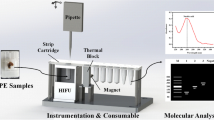Abstract
The aim of the present study was to examine an ultrasound-accelerated fixation technique that reduces the exposure time of the tissue to formaldehyde with respect to the analysis of nucleic acids. We extracted and analysed DNA and RNA from three series of autopsy specimens from five routine cases. Two series were shortly fixed in 4% buffered formalin (15 and 30 min, respectively) whilst being irradiated with high-frequency, high-intensity ultrasound. The last series (control) was routinely fixed in 4% buffered formalin for 24–48 h without irradiation. Although sufficient amounts of DNA of good quality could be extracted and amplified from all three series, the peak heights obtained from conventional fixation were smaller and allele dropout occurred more often, especially for the longer amplicons. RNA yield depended on the fixation procedure, i.e. the shortest fixation time led to the highest RNA yield and quality. No differences were observed with regard to the quality of the histological slides both with conventional and immunohistochemical staining methods. Keeping in mind the increasing need for molecular diagnosis, this fixation technique can be useful to ensure stable quality of nucleic acids in archived autopsy specimens.

Similar content being viewed by others
References
Tsokos M, Herbst H (2005) Black oesophagus: a rare disorder with potentially fatal outcome. A forensic pathological approach based on five autopsy cases. Int J Legal Med 119:146–152
Fineschi V, Karch SB, D'Errico S et al (2006) Cardiac pathology in death from electrocution. Int J Legal Med 120:79–82
Masuda N, Ohnishi T, Kawamoto S, Monden M, Okubo K (1999) Analysis of chemical modification of RNA from formalin-fixed samples and optimization of molecular biology applications for such samples. Nucleic Acids Res 27:4436–4443
Wiegand P, Domhover J, Brinkmann B (1996) DNA-degradation in formalinfixierten Geweben. Pathologe 17:451–454
Loddenkötter B, Becker K, Hohoff C, Brinkmann B, Bajanowski T (2005) Real-time quantitative PCR assay for the detection of Helicobacter pylori: no association with sudden infant death syndrome. Int J Legal Med 119:202–206
Penland SK, Keku T, Torrice C et al (2007) RNA expression analysis of formalin-fixed paraffin-embedded tumors. Lab Invest 87:383–391
Bauer M (2007) RNA in forensic science. Forensic Sci Int Genet 1:69–74
Greer CE, Lund JK, Manos MM (1991) PCR amplification from paraffin-embedded tissues: recommendations on fixatives for long-term storage and prospective studies. PCR Methods Appl 1:46–50
Srinivasan M, Sedmak D, Jewell S (2002) Effect of fixatives and tissue processing on the content and integrity of nucleic acids. Am J Pathol 161:1961–1971
Douglas MP, Rogers S (1998) DNA damage caused by common cytological fixatives. Mutat Res 401:77–88
Finke J, Fritzen R, Ternes P, Lange W, Dolken G (1993) An improved strategy and a useful housekeeping gene for RNA analysis from formalin-fixed, paraffin-embedded tissues by PCR. Biotechniques 14:448–453
Korga A, Wilkolaska K, Korobowicz E (2007) Difficulties in using archival paraffin-embedded tissues for RNA expression analysis. Postepy Hig Med Dosw (Online) 61:151–155
Buchmüller K (1954) The dependence on frequency in utilization of ultrasonics for histological technic. Strahlentherapie 95:316–325
Chu WS, Furusato B, Wong K et al (2005) Ultrasound-accelerated formalin fixation of tissue improves morphology, antigen and mRNA preservation. Mod Pathol 18:850–863
Heinrich M, Matt K, Lutz-Bonengel S, Schmidt U (2007) Successful RNA extraction from various human postmortem tissues. Int J Legal Med 121:136–142
Dettmeyer R, Sperhake JP, Müller J, Madea B (2008) Cytomegalovirus-induced pneumonia and myocarditis in three cases of suspected sudden infant death syndrome (SIDS): diagnosis by immunohistochemical techniques and molecularpathologic methods. For Sci Int 174:229–233
Bajanowski T, Rolf B, Jorch G, Brinkmann B (2003) Detection of RNA viruses in sudden infant death (SID). Int J Legal Med 117:237–240
Haller AC, Kanakapalli D, Walter R, Alhasan S, Eliason JF, Everson RB (2006) Transcriptional profiling of degraded RNA in cryopreserved and fixed tissue samples obtained at autopsy. BMC Clin Pathol 6:9
Heinrich M, Lutz-Bonengel S, Matt K, Schmidt U (2007) Real time PCR detection of five different “endogenous control gene” transcripts in forensic autopsy material. FSI Genet 1:163–169
Acknowledgements
The authors would like to thank Beate Annuß, Kirsten Waterkamp and Ulla Sibbing of the Institute in Münster for their excellent technical support. Thanks to Ulrike Schmidt and Sabine Lutz-Bonengel of the Institute in Freiburg for their helpful comments on the manuscript.
Author information
Authors and Affiliations
Corresponding author
Additional information
Tony Fracasso and Marielle Heinrich contributed equally to this work.
Electronic Supplementary Material
Below is the link to the electronic supplementary material.
Table S1
Comparison of the normalised peak height at different loci by Student’s t test (http://www.physics.csbsju.edu/stats/t-test_bulk_form.html). Only the significant results are shown (DOC 26 kb)
Table S2a
DNA concentration for each sample and peak height at each amplified locus (XLS 62 kb)
Table S2b
Comparison of the normalised peak heights for each group at each locus by Student’s t test. The significant results are depicted in green, the non-significant in red (XLS 50 kb)
Table S2c
Allelic profile of the investigated cases (XLS 39 kb)
Fig. S1
a Section of the lung fixed for 15 min. Actin, ×100. b Section of the lung conventionally fixed. Actin, ×100 (PPT 3.13 mb)
Rights and permissions
About this article
Cite this article
Fracasso, T., Heinrich, M., Hohoff, C. et al. Ultrasound-accelerated formalin fixation improves the preservation of nucleic acids extraction in histological sections. Int J Legal Med 123, 521–525 (2009). https://doi.org/10.1007/s00414-009-0368-1
Received:
Accepted:
Published:
Issue Date:
DOI: https://doi.org/10.1007/s00414-009-0368-1




